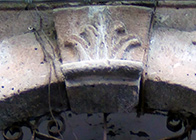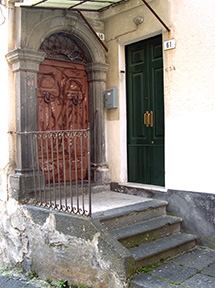| |||||||||||||||||||||||||||||||||||||||||||||
Bronte still preserves an urban
structure of clear Arab inspiration with ancient courtyards, narrow
underpasses, lava stone portals on which Renaissance and
Baroque-inspired architecture has been grafted with stucco and carved
stones of great beauty. | |||||||||||||||||
| |||||||||||||||||
| |||||||||||||||||
| |||||||||||||||||
|
It immediately seemed worthy of attention
but always mysterious and indecipherable. An explanation finally came to us from Prof. Giorgio
Flaccavento, from Ragusa, who in a recent visit to Bronte went to
the place and looked directly at the writing and gave the following
precise and exhaustive deciphering:
The second and third lines have the Greek letter X in common and therefore the second line reads Filius Churion Xristos (Son of the Lord Christ) and the third Deus Jesus Xristos (God Jesus Christ). Vertically, the first line on the left reads Jesus Filius Dei (Jesus Son of God); the second Hominum Churios Jesus (of Men Lord Jesus) and the third Soter Xristos (Savior Christ). The inscription is included in the date 1559 and very likely constitutes the document of the presence of the Friars Minor Observant of Saint Francis before 1593, the year in which the Municipality of Bronte sent the budget to the Court of the Royal Patrimony in which the meat tax in 35 onze was destined for the building of the Convent of the Reformed. In fact, according to what Benedetto Radice reports in his “Memorie storiche di Bronte" (Historical Memoirs of Bronte, reprinted in 1984, page 296, digital edition page 248) in a 1754 memorial attached to a 1759 volume, which is preserved in the Archives of the Chiesa Maggiore, we read that the Church of San Vito and the Convent already existed since 1555.
It can instead be assumed that the Friars Minor Observant were already present in Bronte on that date. Even if the conventual residence was not yet established in a building of its own, for the construction of which we have documentation relating to the 1990s. It is probable, however, that they lodged in several scattered residences, as is documented elsewhere in the same period, for example in Ragusa around the Church of San Rocco. In in this case the date of 1559 would be perfectly compatible with the Memorial of 1754 and would confirm the presence of the Friars Minor Observant since 1555. This is very likely; it remains to be established whether the architrave, on which the date is written, is in its original place, as it would seem at first glance, or whether it was transported there later.» (Professor Giorgio Flaccavento) | |||||||||||||||||
 In this page we wish to present to you another particular aspect that characterizes some houses of the Historic Centre of Bronte: the ancient portals in lava or sandstone, and, above all, the arches and the architraves, masterly sculptured by the ancient stone cutters of Bronte.
In this page we wish to present to you another particular aspect that characterizes some houses of the Historic Centre of Bronte: the ancient portals in lava or sandstone, and, above all, the arches and the architraves, masterly sculptured by the ancient stone cutters of Bronte.











































 We
have always been intrigued by an inscription carved on a large block
of sandstone that serves as an architrave in an old house on Via
Victor Hugo, in whose lunette above you can still read faint traces
of an ancient drawing.
We
have always been intrigued by an inscription carved on a large block
of sandstone that serves as an architrave in an old house on Via
Victor Hugo, in whose lunette above you can still read faint traces
of an ancient drawing. «The
inscription on Via Victor Hugo is not in itself very difficult to
explain because it consists of three lines to be read horizontally
and vertically, the meaning of which is key in the first horizontal
line, which is made up of the monogram (I.H.S.) of Saint Bernardino
of Siena, founder of the Reformed Order of the Minor Observants,
namely Jesus Hominum Salvator (in Greek Soter).
«The
inscription on Via Victor Hugo is not in itself very difficult to
explain because it consists of three lines to be read horizontally
and vertically, the meaning of which is key in the first horizontal
line, which is made up of the monogram (I.H.S.) of Saint Bernardino
of Siena, founder of the Reformed Order of the Minor Observants,
namely Jesus Hominum Salvator (in Greek Soter). Radice
considered the date to be erroneous, which he thought should be read
1595, since there is no mention of the Church and the Convent in the
"Liber Visitationes".
Radice
considered the date to be erroneous, which he thought should be read
1595, since there is no mention of the Church and the Convent in the
"Liber Visitationes".
